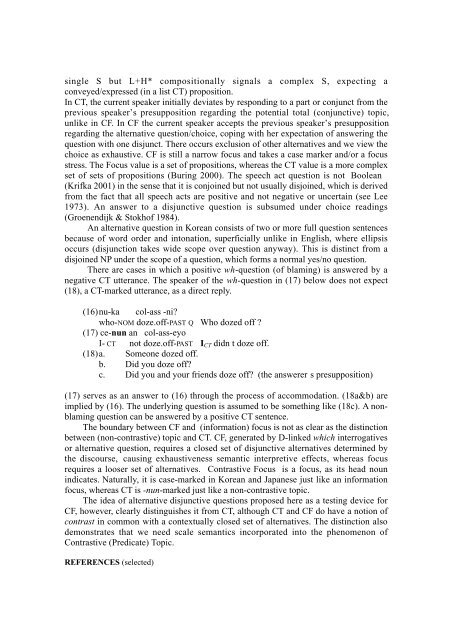SemPrag03.Progr.pdf - Institut für Linguistik/Germanistik - Universität ...
SemPrag03.Progr.pdf - Institut für Linguistik/Germanistik - Universität ...
SemPrag03.Progr.pdf - Institut für Linguistik/Germanistik - Universität ...
You also want an ePaper? Increase the reach of your titles
YUMPU automatically turns print PDFs into web optimized ePapers that Google loves.
single S but L+H* compositionally signals a complex S, expecting a<br />
conveyed/expressed (in a list CT) proposition.<br />
In CT, the current speaker initially deviates by responding to a part or conjunct from the<br />
previous speaker’s presupposition regarding the potential total (conjunctive) topic,<br />
unlike in CF. In CF the current speaker accepts the previous speaker’s presupposition<br />
regarding the alternative question/choice, coping with her expectation of answering the<br />
question with one disjunct. There occurs exclusion of other alternatives and we view the<br />
choice as exhaustive. CF is still a narrow focus and takes a case marker and/or a focus<br />
stress. The Focus value is a set of propositions, whereas the CT value is a more complex<br />
set of sets of propositions (Buring 2000). The speech act question is not Boolean<br />
(Krifka 2001) in the sense that it is conjoined but not usually disjoined, which is derived<br />
from the fact that all speech acts are positive and not negative or uncertain (see Lee<br />
1973). An answer to a disjunctive question is subsumed under choice readings<br />
(Groenendijk & Stokhof 1984).<br />
An alternative question in Korean consists of two or more full question sentences<br />
because of word order and intonation, superficially unlike in English, where ellipsis<br />
occurs (disjunction takes wide scope over question anyway). This is distinct from a<br />
disjoined NP under the scope of a question, which forms a normal yes/no question.<br />
There are cases in which a positive wh-question (of blaming) is answered by a<br />
negative CT utterance. The speaker of the wh-question in (17) below does not expect<br />
(18), a CT-marked utterance, as a direct reply.<br />
(16)nu-ka col-ass -ni?<br />
who-NOM doze.off-PAST Q Who dozed off ?<br />
(17) ce-nun an col-ass-eyo<br />
I- CT not doze.off-PAST I CT didn t doze off.<br />
(18)a. Someone dozed off.<br />
b. Did you doze off?<br />
c. Did you and your friends doze off? (the answerer s presupposition)<br />
(17) serves as an answer to (16) through the process of accommodation. (18a&b) are<br />
implied by (16). The underlying question is assumed to be something like (18c). A nonblaming<br />
question can be answered by a positive CT sentence.<br />
The boundary between CF and (information) focus is not as clear as the distinction<br />
between (non-contrastive) topic and CT. CF, generated by D-linked which interrogatives<br />
or alternative question, requires a closed set of disjunctive alternatives determined by<br />
the discourse, causing exhaustiveness semantic interpretive effects, whereas focus<br />
requires a looser set of alternatives. Contrastive Focus is a focus, as its head noun<br />
indicates. Naturally, it is case-marked in Korean and Japanese just like an information<br />
focus, whereas CT is -nun-marked just like a non-contrastive topic.<br />
The idea of alternative disjunctive questions proposed here as a testing device for<br />
CF, however, clearly distinguishes it from CT, although CT and CF do have a notion of<br />
contrast in common with a contextually closed set of alternatives. The distinction also<br />
demonstrates that we need scale semantics incorporated into the phenomenon of<br />
Contrastive (Predicate) Topic.<br />
REFERENCES (selected)

















